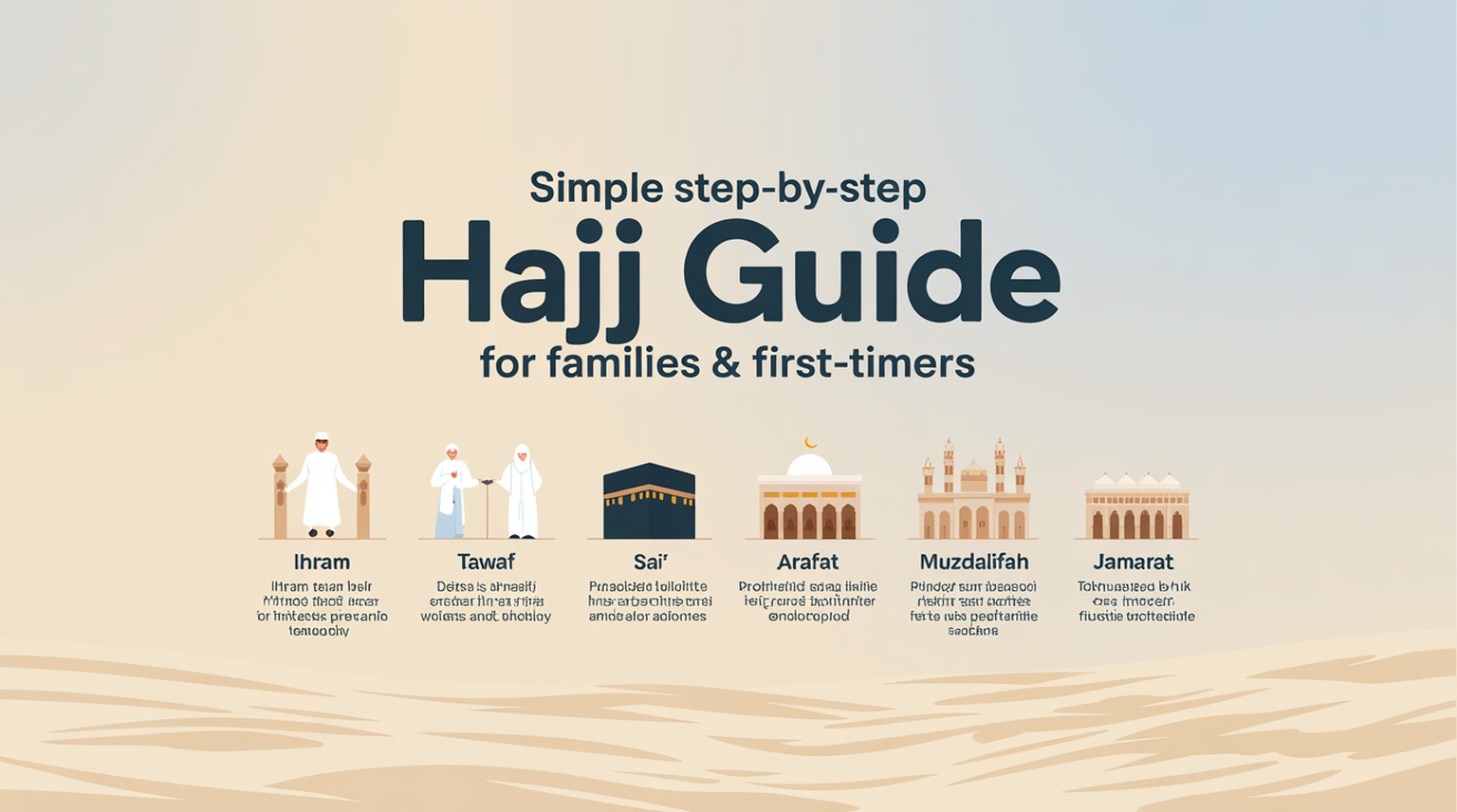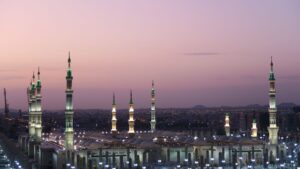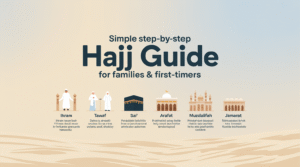The Hajj pilgrimage to Mecca is the fifth and most sacred pilgrimage of Islam. If you are physically fit and financially stable, then every Muslim should perform Hajj at least once in their lifetime. The Hajj is performed during the month of Dhul-Hijjah. It is an exhibition of profound faith, self-sacrifice, and love for Allah. This sacred journey symbolizes harmony, peace, and the obedience of Muslims to Allah ﷻ.
Simple Step-by-Step Hajj Guide
Hajj has a religious and historical significance. The pilgrims are following the actions of Prophet Ibrahim (Abraham) and his family members. Bestowing honor on them and demonstrating their zeal and sacrifice. The majority of USA Muslims search for authentic Hajj Packages 2026 so that their travel, stay, and medication needs become hassle-free and easy for them. Hajj comprises independent rituals: Ihram (plain white unsown garments), Tawaf of the Kaaba, and Arafat prayer.
Rituals of Hajj occur between five or six days of the 8th to 13th date of Dhul-Hijjah. Hajj is the biggest religious festival that occurs every year in Islam.
Step 1: Ihram and Intentions
Two of the first fundamental things to perform Hajj are niyyah of cleanliness and the ornament of Ihram. Once the niyyah is done, Muslim pilgrims have substituted Ihram- two unstitched white clothes for males and a lady’s Abaya, a loose outer covering over the entire body. Pilgrims need to say Talbiyah once already in Ihram and have to leave all sins behind. Since Muslims are already in Makkah, their pilgrimage would be a mix of Umrah and Hajj rituals. Muslims then perform circumambulation of the Holy Kaaba 7 anticlockwise, commonly known as Tawaf. They finish tawaf in prayer, generally on the back side of Maqam Ibrahim, and proceed to the second half of Umrah, between Safa and Marwa mountains. Umrah pilgrims carry out Umrah and set off the procession from Mina afterwards.
Step 2 Mina, or “City of Tents”
5 or 6 kilometres from Makkah, there is a small town called Mina. Pilgrims are requested to stay overnight and remain in the tent city of Mina upon their arrival. Booking Hajj Visa beforehand is a very crucial task to reserve in advance for such a pilgrimage by the majority of the USA Muslims, as they can get easy access to such a holy land without any delay.
All five Salahs are recited by the pilgrims between Fajr prayer and Zuhr prayer while residing in Mina. The land where Mina is located today is covered with tents. Fard and non-fard prayers obligatory on Muslims to read after residing in Mina have to be done by them.
Step 3 Mina to Arafat, 9th Day of Dhul-Hijjah
On 9th Dhul-Hijjah, pilgrims head to Arafat and recite Talbiyah. Muslim pilgrims offer Zuhr Asr prayer. They recite duas if they are within the boundary of the Arafat. It is also known as Wuquf – standing before Allah (SWT) and read in the nearby place within the boundary of Jabal al-Rahmah during noon until evening.
Step 4 Muzdalifah
Pilgrims go for a walk to the second Hajj destination, Muzdalifah, a village between Mount Arafat and Mina. Pilgrims doing the evening prayer in Muzdalifah fields at sunset do Maghribaen Isha and Maghrib together. Many of the USA Muslims meet fellow believers here in one aspect of humility and oneness under the open sky. They spend the night at Muzdalifah as all pilgrims do and collect 49 small stones of equal size to be hurled during the Rami ritual. Pilgrims depart from Muzdalifah town early in the morning of the 10th of Dhul-Hijjah. Tawaf al-Ifadah and Sa’i
Pilgrims return to Makkah again to do Tawaf al-ifadah and Sa’i between Marwa and Safa hills. Muslims return to Mina again to undertake Rami, Nahr, and Halq rituals.
Step 5 Rami (Stoning the Devil)
Pilgrims, such as Mina pilgrims, act at Rami by stoning Jamarat al-Aqabah. Seven stones are thrown on the pillar complex. Rami is performed by Rami during the noon time daily. Rami is performed on the 11th and 12th of Dhul-Hijjah.
Step 6 Nahr
Following Rami, on 12th Dhul-Hijjah, Muslim pilgrims are required to offer an offering of sacrifice, and they are allowed to sacrifice a camel or a lamb. Pilgrims may buy sacrifice coupons or vouchers, upon which the sacrifice will be indicated, so that it has been done on their behalf. The meat of the sacrificed animal should be distributed among poor persons.
Halq and Taqsir
Halq is shaving, while Taqsir is cutting or clipping. They must clip or shave their head when giving the blessed sacrifice. She is not required to shave as a female pilgrim, so she must clip a single strand or lock of her hair.
Step 7: Farewell Tawaf
After completing all the rituals of the hajj, pilgrims then go back to the Holy Kabba. At this spiritual holy Kabba, they will do the final tawaf of the hajj known as “Tawaf al-Wada’. After this Tawaf, they will do the Sa’i. So this is officially the End of the Holy pilgrimage. But some people also visit Madina before they go back to their homes.
Conclusion
Hajj itself is not a worldly journey; Hajj is a spiritual, religious pilgrimage that completely transforms the life of the pilgrim. Muslims are provided with a new life in Islam, forgiveness, and obedience to living Islam as a lifestyle during Hajj. Hajj makes the Muslim Ummah of the world even stronger, transforming the religion, unity, and obedience to Allahﷻ.




